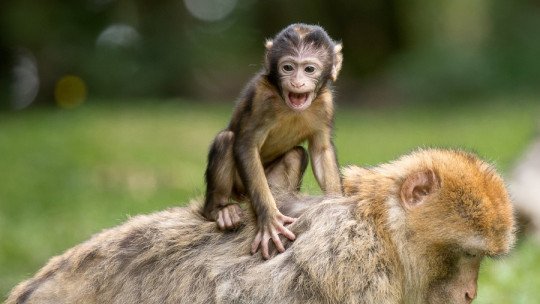
In research that seeks to find the origins of the human species that connect us with apes, understanding and focusing on emotions is extremely important. Understanding the origin of emotions is key to finding explanations for our emotional reactions and knowing the survival function they have had throughout history.
In this evolutionary fabric that does not connect primates, the emotion of fear has been understood as a driving force for survival. However, The fearful ape hypothesis challenges conventional conceptions by exploring fear not only as an individual defensive mechanism, but as a fundamental catalyst for the formation and strengthening of cooperative communities. This innovative concept challenges the notion of whether fear is exclusive to external threats.
In this article, we are going to explore in greater depth the origin of fear in primates. The evolution of fear, from its origins in our common ancestors to its expression in contemporary emotional complexities, will be examined with a magnifying glass that challenges long-held perceptions. As we unravel the fearful ape hypothesis, intriguing questions will arise about how these evolutionary dynamics have left their mark on current human society.
What is the fearful ape hypothesis?
The fearful ape hypothesis is framed in the evolution of fear in both humans and other primates, addressing the emotional complexities that have arisen over time. To understand the genesis of this hypothesis, it is essential to delve into the relationship between fear and cooperation, crucial characteristics in evolutionary development.
Fear, from an evolutionary perspective, has played a crucial role in the survival of species. In the case of primates, including humans, the ability to perceive and respond to fear has been essential to avoid threats and ensure the survival of the group. The fearful ape hypothesis proposes that this ability not only has defensive value, but has also been shaped by the need to foster cooperation.
The key to this hypothesis lies in the idea that Fear not only arises in response to external threats, but is also intrinsically linked to the need for care and social cooperation Over the course of evolution, individuals who experienced more acute fear might have developed stronger social bonds, as group cooperation provides a collective shield against potential dangers.
This integrative approach to fear in the evolutionary context not only expands our understanding of the role of fear in individual survival, but also sheds light on the formation and strength of communities. The fearful ape hypothesis therefore suggests a profound connection between the emotion of fear and the construction of cooperative societies, challenging previous conceptions that limited fear to a purely defensive role.
Research and evidence in Biology and Psychology
To support the fearful ape hypothesis, different researchers have carried out various exhaustive studies that address both the biological basis and behavioral manifestations of fear in primates, in addition to taking in some cases a special approach focused on humans and their close relatives. The research methods, in the findings that will be discussed here, generally involved the observation of behaviors in natural environments and the evaluation of physiological responses to fearful stimuli.
Results in these types of studies have revealed surprising patterns in the triggering of the fear response. In situations of perceived risk, fear responses have been observed not only at the individual level but also at the group level These findings point to the idea that fear not only operates on a personal level, but also has a collective impact, influencing social interactions and strengthening ties within the community.
At a biological level, specific neurobiological correlates associated with fear shared between humans and other primates have been identified. These include the activation of brain areas associated with emotional responses, as well as changes in the release of key neurotransmitters. These similarities support the notion that the ability to experience and respond to fear has deep evolutionary roots, dating back to our common ancestors with other primates.
One of the most intriguing aspects of these results is the observation of heightened cooperative behaviors in fearful situations among the groups of apes observed and studied. Individuals showed an increase in positive social interactions, such as mutual care and cooperation in foraging This suggests that fear, rather than triggering isolationist responses, may have acted as a mechanism to strengthen social bonds, thus contributing to the evolutionary success of communities.
These findings challenge the traditional view of fear as an emotion simply oriented toward self-defense. Rather, they support the fearful ape hypothesis by proposing that fear, by influencing cooperation, has been a key factor in building and maintaining human and primate societies. The connection between fear and cooperation is not only manifested in behavioral responses, but is also reflected in the structure and function of the brain, providing a comprehensive basis for understanding this innovative hypothesis.
Implications and significance of these discoveries
The fearful ape hypothesis offers fascinating insights into the intersection between fear and cooperation, raising profound questions about the evolution of human and primate societies. If we consider that fear has evolved not only as an individual survival mechanism but also as a driver of group cooperation, significant implications arise.
In evolutionary terms, this connection suggests that communities that developed greater sensitivity to fear may have experienced adaptive advantages. The ability to coordinate collective responses to threats, thanks to the intensification of fear, could have made the difference in terms of survival and reproduction. This perspective offers a new lens through which we can understand the formation and success of human and primate societies.
Furthermore, the fearful ape hypothesis raises questions about how these evolutionary dynamics have influenced culture and social norms How is the connection between fear and cooperation reflected in our contemporary social structures? To what extent can human interactions, from collaboration to conflict, be traced back to this evolutionary interplay between fear and cooperation?
From a broader perspective, this hypothesis could also have consequential implications for fields such as social psychology, anthropology, and neuroscience. Understanding how fear has been a catalyst for the formation of cooperative societies can inspire new research and theories in these fields, thus contributing to the comprehensive understanding of human nature and other primates.
Ultimately, the fearful ape hypothesis challenges us to reconsider the evolution of fear beyond its traditional function of response to individual danger. This also opens the door, furthermore, to reconsider the origin and psychological explanation of other emotions. If fear has been able to be studied from another point of view and origin, why couldn’t it be done for other differentiated emotions? Exploring their role in the formation and maintenance of group cooperation, this perspective invites us to rethink our conceptions about the nature of societies and the complexity of human and primate emotions.
Criticism and open questions
Despite the innovative proposal of the fearful ape hypothesis, as in any scientific theory, there are criticisms and unresolved questions that deserve our attention. Some critics might argue that the connection between fear and cooperation is an oversimplification of complex emotional and behavioral processes.
Additionally, it is essential to address the limitations of the study on which the hypothesis is based. How can these results be extrapolated to various primate populations and, ultimately, to humans? Are there significant variations in fear responses between different human species or groups?
Another intriguing question that arises is whether heightened fear always leads to greater cooperation or whether there are specific conditions under which fear could lead to more selfish or even aggressive behaviors. These open questions invite future research and debate in the field. Science advances as we confront difficult questions and critically consider proposed theories. In this sense, the fearful ape hypothesis marks a starting point, but also an invitation to the scientific community to further explore the nuances of the relationship between fear and cooperation in the evolution of primates, including humans.
Conclusions
In conclusion, the fearful ape hypothesis provides a new perspective on the evolution of fear, suggesting that its function goes beyond individual self-defense. Findings supported by biological and behavioral evidence suggest that fear has been a key facilitator of social cooperation in primates. Although subject to criticism and open questions, this hypothesis sparks a fascinating dialogue about the complexity of emotions and social interactions in the evolution of species.








